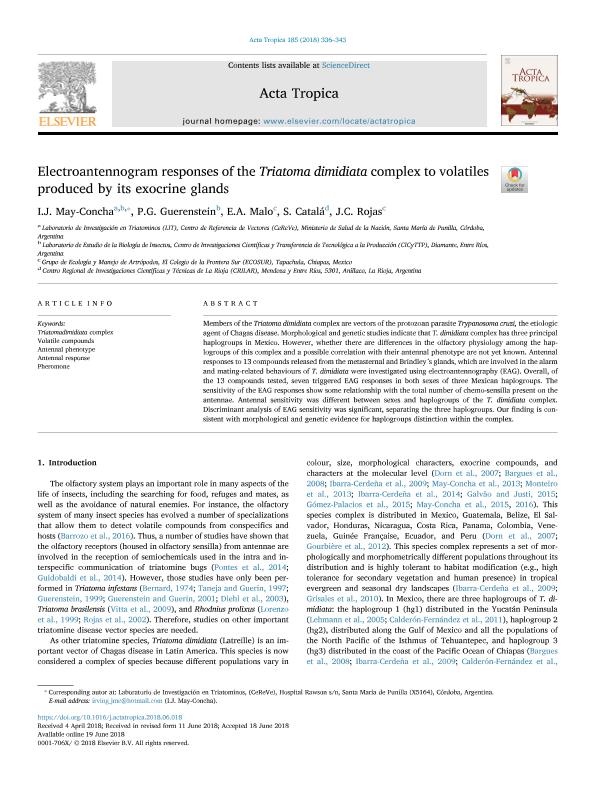Artículo
Electroantennogram responses of the Triatoma dimidiata complex to volatiles produced by its exocrine glands
May Concha, Irving Jesus ; Guerenstein, Pablo Gustavo
; Guerenstein, Pablo Gustavo ; Malo, E. A.; Catala, Silvia Susana
; Malo, E. A.; Catala, Silvia Susana ; Rojas, J. C.
; Rojas, J. C.
 ; Guerenstein, Pablo Gustavo
; Guerenstein, Pablo Gustavo ; Malo, E. A.; Catala, Silvia Susana
; Malo, E. A.; Catala, Silvia Susana ; Rojas, J. C.
; Rojas, J. C.
Fecha de publicación:
09/2018
Editorial:
Elsevier Science
Revista:
Acta Tropica
ISSN:
0001-706X
Idioma:
Inglés
Tipo de recurso:
Artículo publicado
Clasificación temática:
Resumen
Members of the Triatoma dimidiata complex are vectors of the protozoan parasite Trypanosoma cruzi, the etiologic agent of Chagas disease. Morphological and genetic studies indicate that T. dimidiata complex has three principal haplogroups in Mexico. However, whether there are differences in the olfactory physiology among the haplogroups of this complex and a possible correlation with their antennal phenotype are not yet known. Antennal responses to 13 compounds released from the metasternal and Brindley´s glands, which are involved in the alarm and mating-related behaviours of T. dimidiata were investigated using electroantennography (EAG). Overall, of the 13 compounds tested, seven triggered EAG responses in both sexes of three Mexican haplogroups. The sensitivity of the EAG responses show some relationship with the total number of chemo-sensilla present on the antennae. Antennal sensitivity was different between sexes and haplogroups of the T. dimidiata complex. Discriminant analysis of EAG sensitivity was significant, separating the three haplogroups. Our finding is consistent with morphological and genetic evidence for haplogroups distinction within the complex.
Archivos asociados
Licencia
Identificadores
Colecciones
Articulos(CICYTTP)
Articulos de CENTRO DE INV.CIENT.Y TRANSFERENCIA TEC A LA PROD
Articulos de CENTRO DE INV.CIENT.Y TRANSFERENCIA TEC A LA PROD
Citación
May Concha, Irving Jesus; Guerenstein, Pablo Gustavo; Malo, E. A.; Catala, Silvia Susana; Rojas, J. C.; Electroantennogram responses of the Triatoma dimidiata complex to volatiles produced by its exocrine glands; Elsevier Science; Acta Tropica; 185; 9-2018; 336-343
Compartir
Altmétricas



